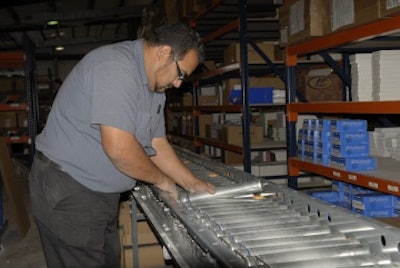
Taken for granted and often ignored, a conveyor system turns out to be a critical link in a company's distribution system when a conveyor fails. Then, it becomes a major issue—production stops, employees are idle, shipments are late, customers are upset—and the company's reliability is questioned.
It's always the seemingly small things—like a conveyor breakdown—that raise havoc, escalate costs, and reduce profits.
The following are 12 of the most common material handling system maintenance mistakes and how to avoid them:
1. Lack of regular inspections.
In most manufacturing operations, it's the production equipment that receives the attention, while it's the products that are important in a distribution center. A conveyor system, no matter how basic or complex, is almost an "invisible" link in the total process.
Yet, many facilities fail to take a few seconds to make a quick inspection. For example, if you have a belt conveyor, check the floor area underneath the conveyor while it's operating for dust-like shavings. When you see them, it's a sign that the belt is out of alignment, isn't tracking properly, is wearing unnecessarily, and will eventually be damaged. Always be aware of squeaks. They aren't normal; they're signals that something needs attention.
Regular inspections also serve to help familiarize employees stationed at conveyors to better understand the equipment they are using and to take ownership of its care.
2. Missing maintenance records.
A maintenance log kept on or near the system with information on what maintenance has been performed and the date, along with anything that should be watched, can be particularly useful in facilities where there are several shifts. It's also helpful if there is a change in personnel. Most importantly, it helps document the history of the equipment and can support your case if there is ever an issue with a manufacturer.
3. Failing to take the temperature of motors and reducers.
Motors can overheat. A temperature spike indicates that something is causing an overload. In some cases, a conveyor is being used for materials for which it was not designed or an inappropriate conveyor has been pressed into service.
Having to replace a burned out motor during a production period means downtime, particularly since most facilities don't have a backup supply.
4. Not adhering to OSHA standards.
Maintaining a high level of safety when it comes to equipment is not always easy. Because of the constant pressure in a production environment, it's easy to neglect equipment safety. When reviewing facilities, it is easy to spot missing chain guards on conveyors, for example. The required pans underneath belt conveyors have either come off or been removed for one reason or another. More often than not, everyone is busy, and safety equipment is not reinstalled after being removed.
Injuries are costly in time lost, the need to replace an employee, and Worker's Compensation costs. In many cases, investigation reveals that the cause of injuries is the direct result of missing safety equipment.
5. Lack of adequate maintenance coverage.
To reduce overhead expenses, fewer maintenance personnel are on the job.
A cost-effective solution is having an experienced, certified conveyor service technician make periodic inspections and be on-call when in-house coverage isn't available.
6. Inadequate parts inventory. As many learn too late, certain parts may not be readily available when there's a breakdown. While it's not appropriate to inventory every part, there are certain key components, such as motors, couplings for line shafts, bearings, and photo eyes, that should be kept on hand.
Survey your conveyor system and draw up a list of key components including part numbers.
7. Not learning from repeated breakdowns. An ongoing pattern of breakdowns is a message that something is wrong.
Yet, having to replace a coupling on a line-shaft conveyor, for example, should be an alert that there is a problem that needs to be investigated and resolved. Failing to do this only results in more downtime incidents, additional costs, and employee frustration.
8. "If it isn't broken, just let it go and don't worry about it."
We've all heard those words, yet waiting to make repairs until a conveyor system breaks down is a costly mistake.
9. Failing to care for the controls.
As systems have become more technologically sophisticated, ignoring their maintenance can be disastrous. Here are two examples. First, switching scanners without recognizing that each one is programmed for a particular divert can create problems, yet it happens all the time.
Also, lightning strikes can knock out a control's programming as a result of not having a proper surge protection. Again, more downtime and costly emergency repairs are needed to get up and running.
10. Using a conveyor in ways it wasn't intended.
A need arises and a conveyor system is pressed into service without consideration of its capabilities. One of the most common examples is placing larger, heavier cartons on a narrow conveyor. When this happens, there is stress and wear on the entire conveyor, which will eventually result in a breakdown.
11. Avoiding those difficult places.
Wherever there's equipment, there are difficult places to get to, sometimes up high or around in back, and most of the time there is too little room to maneuver. These are the breeding grounds for expensive repairs and operational issues. It's these places that are rarely, if ever, lubricated. This is where you find loose chains and sprocket set screws, causing extra strain on the system and creating an emergency waiting to happen.
12. Failing to train employees in the operation of conveyors.
One of the major causes of unnecessary maintenance costs is failing to train employees on how to use the conveyors. By knowing how conveyors operate, how to avoid their misuse, and how to spot maintenance issues, employees become the first line of defense for minimizing problems and reducing costs.
While some may see it as "only a conveyor," others recognize it as a critical link in meeting deadlines, getting orders filled properly and accurately, and reducing overhead costs. Avoiding unnecessary mistakes with conveyors is simply good business.
Thomas E. Betts is Installation and Service Manager at TriFactor, a material handling systems integrator based in Lakeland, FL. Tom Betts has had more than 20 years experience in working with conveyor systems. He can be contacted at 863/577-2230 or [email protected].
It's always the seemingly small things—like a conveyor breakdown—that raise havoc, escalate costs, and reduce profits.
The following are 12 of the most common material handling system maintenance mistakes and how to avoid them:
1. Lack of regular inspections.
In most manufacturing operations, it's the production equipment that receives the attention, while it's the products that are important in a distribution center. A conveyor system, no matter how basic or complex, is almost an "invisible" link in the total process.
Yet, many facilities fail to take a few seconds to make a quick inspection. For example, if you have a belt conveyor, check the floor area underneath the conveyor while it's operating for dust-like shavings. When you see them, it's a sign that the belt is out of alignment, isn't tracking properly, is wearing unnecessarily, and will eventually be damaged. Always be aware of squeaks. They aren't normal; they're signals that something needs attention.
Regular inspections also serve to help familiarize employees stationed at conveyors to better understand the equipment they are using and to take ownership of its care.
2. Missing maintenance records.
A maintenance log kept on or near the system with information on what maintenance has been performed and the date, along with anything that should be watched, can be particularly useful in facilities where there are several shifts. It's also helpful if there is a change in personnel. Most importantly, it helps document the history of the equipment and can support your case if there is ever an issue with a manufacturer.
3. Failing to take the temperature of motors and reducers.
Motors can overheat. A temperature spike indicates that something is causing an overload. In some cases, a conveyor is being used for materials for which it was not designed or an inappropriate conveyor has been pressed into service.
Having to replace a burned out motor during a production period means downtime, particularly since most facilities don't have a backup supply.
4. Not adhering to OSHA standards.
Maintaining a high level of safety when it comes to equipment is not always easy. Because of the constant pressure in a production environment, it's easy to neglect equipment safety. When reviewing facilities, it is easy to spot missing chain guards on conveyors, for example. The required pans underneath belt conveyors have either come off or been removed for one reason or another. More often than not, everyone is busy, and safety equipment is not reinstalled after being removed.
Injuries are costly in time lost, the need to replace an employee, and Worker's Compensation costs. In many cases, investigation reveals that the cause of injuries is the direct result of missing safety equipment.
5. Lack of adequate maintenance coverage.
To reduce overhead expenses, fewer maintenance personnel are on the job.
A cost-effective solution is having an experienced, certified conveyor service technician make periodic inspections and be on-call when in-house coverage isn't available.
6. Inadequate parts inventory. As many learn too late, certain parts may not be readily available when there's a breakdown. While it's not appropriate to inventory every part, there are certain key components, such as motors, couplings for line shafts, bearings, and photo eyes, that should be kept on hand.
Survey your conveyor system and draw up a list of key components including part numbers.
7. Not learning from repeated breakdowns. An ongoing pattern of breakdowns is a message that something is wrong.
Yet, having to replace a coupling on a line-shaft conveyor, for example, should be an alert that there is a problem that needs to be investigated and resolved. Failing to do this only results in more downtime incidents, additional costs, and employee frustration.
8. "If it isn't broken, just let it go and don't worry about it."
We've all heard those words, yet waiting to make repairs until a conveyor system breaks down is a costly mistake.
9. Failing to care for the controls.
As systems have become more technologically sophisticated, ignoring their maintenance can be disastrous. Here are two examples. First, switching scanners without recognizing that each one is programmed for a particular divert can create problems, yet it happens all the time.
Also, lightning strikes can knock out a control's programming as a result of not having a proper surge protection. Again, more downtime and costly emergency repairs are needed to get up and running.
10. Using a conveyor in ways it wasn't intended.
A need arises and a conveyor system is pressed into service without consideration of its capabilities. One of the most common examples is placing larger, heavier cartons on a narrow conveyor. When this happens, there is stress and wear on the entire conveyor, which will eventually result in a breakdown.
11. Avoiding those difficult places.
Wherever there's equipment, there are difficult places to get to, sometimes up high or around in back, and most of the time there is too little room to maneuver. These are the breeding grounds for expensive repairs and operational issues. It's these places that are rarely, if ever, lubricated. This is where you find loose chains and sprocket set screws, causing extra strain on the system and creating an emergency waiting to happen.
12. Failing to train employees in the operation of conveyors.
One of the major causes of unnecessary maintenance costs is failing to train employees on how to use the conveyors. By knowing how conveyors operate, how to avoid their misuse, and how to spot maintenance issues, employees become the first line of defense for minimizing problems and reducing costs.
While some may see it as "only a conveyor," others recognize it as a critical link in meeting deadlines, getting orders filled properly and accurately, and reducing overhead costs. Avoiding unnecessary mistakes with conveyors is simply good business.
Thomas E. Betts is Installation and Service Manager at TriFactor, a material handling systems integrator based in Lakeland, FL. Tom Betts has had more than 20 years experience in working with conveyor systems. He can be contacted at 863/577-2230 or [email protected].























